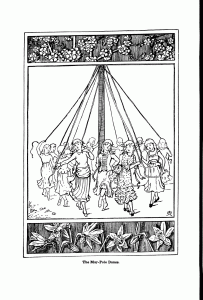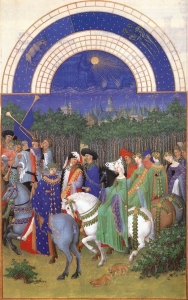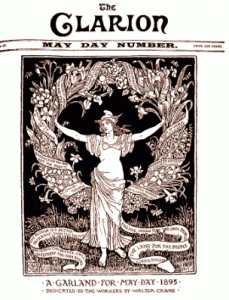
Adelia Belle Beard (1857-1920)|May Pole Dance, 1887|The American Girls Handy Book: How to Amuse Yourself and Others by Lina Beard and Adelia B. Beard (New York: Charles Scribner’s Sons, 1887): 71.
In the 1880s, when Adelia Belle Beard drew this sweet image of the May Pole Dance, how innocent the young girls looked. Also particularly handsome are the floral borders of daffodils and apple blossoms that frame the image.
In their book on How to Amuse Yourself and Others (1887), Lina (Mary Caroline Beard) and Adelia Beard outline and describe the history of the May Day holiday, some of the activities of the celebration, including how to construct and dance around a May Pole. This holiday traditionally honors the Roman goddess of flowers and was held the last four days of April and the first of May. Lina and Adelia Beard were sisters to the illustrator Daniel Carter Beard, the founder of the Boy Scouts of America.* In the early 1880s, Lina and Adelia founded the nation’s first girl’s scouting group, now known as the Camp Fire Girls. The sisters were also authors of a variety of books as well as artists and illustrators.
The Roman celebration of spring was also associated with the celebration of Beltane, the May 1st celebration of flowers, fertility, and re-birth, it eventually became Christianized. In the middle ages, the custom of going ‘a-maying’ referred to the collecting of flowers and greenery to decorated the maypole.
Illustration art owes its beginnings to the illuminated manuscripts and decorated scrolls produced before the invention of the printing press by Johannes Gutenberg around 1440. One of the classic examples of fabulous manuscript illumination can be seen in a medieval book of hours, a collection of texts for each liturgical hour of the day including supplementary texts of prayers, psalms, and masses for certain holy days. This specific book of hours, Les Très Riches Heures du duc de Berry was the work of the Limbourg Brothers who were from an artistic Flemish family. The Très Riches Heures was commissioned by Jean, the Duc de Berry around 1410. To decorate its 416 pages, it has 131 large illuminated images not including border decorations, or historiated (decorated) initials.

Limbourg Brothers, Paul, Hermann, and Jean (late 14th and early 15th century)|Mai, between 1412 and 1416|Illustration for Les Très Riches Heures du duc de Berry
Each month’s illustration shows something of life in that season and are framed at the top by the zodiac symbols for that period. For the month of May, the brothers illustrated a mounted pageant celebrating the “joli mois de Mai,” when participants wore green garments and decked themselves out in trailing green vines. The riders are young nobles including some royals. In the background of the image is a chateau thought to be either the Duke’s Paris residence or the Palais de la Cite in Paris.
Eventually May Day and the may pole took on other connotations. In the 1890s, the English illustrator Walter Crane produced illustrations to commemorate May Day for the socialist magazine The Clarion. The socialists considered May Day their Labor Day and used its celebration to urge an eight-hour work day, work that was rewarding rather than demoralizing or exhausting, and that children should enjoy a healthy childhood rather than being forced into child labor.
Later, the Nazis celebrated the fertility aspect of May Day events to reinforce their promotion of large Aryan families. Eventually some countries (such as the U. S. S. R.) used May Day parades to emphasize their military prowess.
Isn’t it amazing all the things illustration reference?
* Daniel Carter Beard (1850-1941) was the primary illustrator of Mark Twain’s books in their earliest permutations. The Beard sibling’s father was the artist James Henry Beard (1811-1893) who also was their primary teacher and among his various pupils was the genre painter, Lilly Martin Spencer (1822-1902).
April 29, 2010
By Joyce K. Schiller, Curator, Rockwell Center for American Visual Studies,
at the Norman Rockwell Museum







